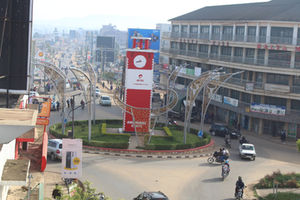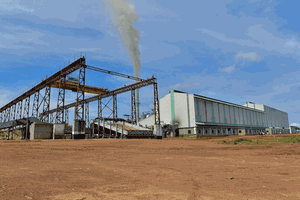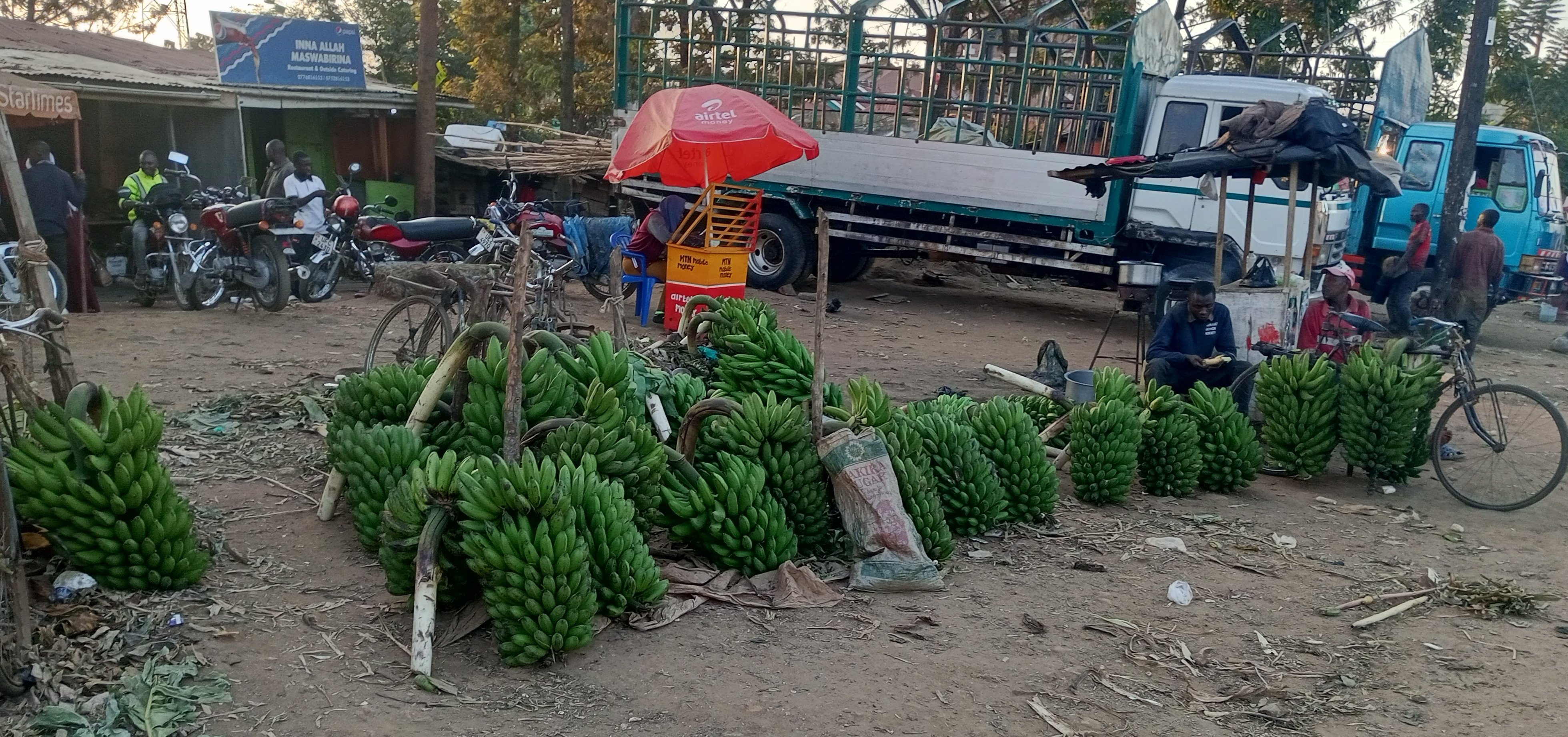
Matooke vendors in a market in Kabudaire, Fort Portal City, yesterday. PHOTO | ALEX ASHABA
Farmers from several parts of the country have suffered substantial losses following a drastic drop in the prices of matooke.
Matooke is a major cash crop in eastern, central, and western parts of Uganda, and is lately increasingly being grown in the north.
However, between May and July every year, farmers report bumper harvests, forcing the prices to drop to as low as Shs3,000.
Currently, the farm gate price of a big bunch of matooke is between Shs5,000 and Shs17,000, down from between Shs20,000 and Shs30,000.
In Kabarole District and Fort Portal City, farmers have reported a sharp decline in demand, with the price of a bunch dropping to between Shs5,000 and Shs7,000, from between Shs15,000 and Shs20,000.
However, not all is lost. Dr Halid Kirunda, the director of research at Mbarara Zonal Agricultural Research and Development Institute (ZARDI), says value addition in bananas is the way to go.
Apart from making juice from ripe bananas, farmers can peel raw matooke into chips, dry, package and store it for some time. Such matooke is also exported.
Dr Kirunda says after extracting juice from the bananas, such juice can also be improved by processing wine, which can be sold locally and abroad.
“We make powder for confectioneries, we can mix bananas with wheat to make bread and reduce the amount of wheat in bread which helps in reducing cholesterol in wheat,” Dr Kirunda says, adding that turning bananas into wheat will help the country reduce the importation of wheat as well as increase the exportation of the banana flour.
“Banana has a high content of potassium, which helps a lot of people who depend on bread. We can extract juice from the ripe bananas using the enzyme method rather than the traditional method where they use yeast. The enzyme method brings out clean juice and in large amounts,” he says.
The Yumbe District agricultural officer, Mr Gard Feni, says though the prices of matooke have gone down, it is not good to depend only on one crop.
“It is advisable for farmers to grow varieties of staple food so that in case one crop loses market, the other crops help offset the loss. Farmers can also add value to matooke by making products such as bread and chips, among others,” he says.
Mr Feni also says farmers who have already harvested their matooke can preserve it in cool places so it doesn’t go bad.
The Jinja City principal commercial officer, Mr Roger Kuboyo, says there is a need for the government to establish factories for value addition in matooke producing areas.
“In Bushenyi, the government constructed matooke factory to help farmers in western Uganda market their produce but because there is lack of sensitisation to them, they end up bringing raw matooke to the market, resulting in price fluctuation,” Mr Kuboyo says.
Dr Paul Kigenyi, the former Jinja District National Agricultural and Advisory Services (Naads) coordinator, says farmers can use their ripening matooke to squeeze juice for making alcohol which can be stored for a longer time.
Dr Kigenyi says the government should establish a market for matooke in the neighbouring countries.
Government plan
The Ministry of Agriculture, Animal Industry and Fisheries (MAAIF) earlier pledged to harness opportunities for value addition along the matooke (banana) value-chain, as the government looks to mechanisation and modernisation of agriculture.
The ministry said processing matooke into different products would address the largely subsistence nature of agricultural production and help address the current nationwide fall in banana prices.

Energy Minister Ruth Nankabirwa admires matooke produced by Mr Bruce Benywanira in Isingiro District last month. PHOTO | RAJAB MUKOMBOZI
This newspaper has established that in the whole of western Uganda, there is only one factory for value addition for matooke called Banana Industrial Research and Development Centre in Bushenyi District. The factory is a presidential initiative that was designed to enable smallholder farmers in the Greater Ankole area to add value addition on matooke and enhance their yields.
Members of Parliament have, however, called for a scrutiny of the Presidential Initiative on Banana Industrial Development to prove value for money.
The MPs reason that 20 years since its establishment, queries have risen about its operations, finances, and its production capacity. But its management says they have started mass production of the bananas and that they have transitioned from research to the commercialisation stage.
Mr Hassan Mafabi, a matooke vendor at Mbale Central Market in Mbale City, says the price of matooke has recently dropped due to the increasing number of trucks of the crop coming from the western region.
He adds that a big bunch of matooke is now being sold between Shs15,000 and Shs17,000. Mr Julius Magomu, another vendor, says a few months ago, they would sell a big bunch of matooke at between Shs20,000 and Shs30,000 but now it goes for less than Shs15,000.
The situation is the same in Tororo. Mr Ismail Okello, a trader in Tororo market, says a bunch of matooke that was sold at Shs20,000 is now being sold at Shs12,000.
Mr Jude Wamukota, another matooke trader from Bugobero in Manafwa, says the decline in prices has made it difficult for him and his family to survive.
“On average, I would sell five bunches at Shs100,000 but currently the highest amount I get is Shs70,000 as some of my customers, especially hoteliers, buy direct from trucks that ferry from other regions,” he says.
In Masaka City, a bunch of matooke costs between Shs8,000 and Shs18,000.
Mr Charles Kabuye, a matooke dealer, says: “To address this, the government should install refrigeration facilities in matooke growing districts to store it during surplus seasons and bring it for sale during scarcity.”
In Arua City, the price of matooke is relatively high because it is off-season, according to dealers.
Mr Leonard Acidri, who transports matooke from Logiri Sub-county in Arua District to Arua City, says: “These days a small bunch costs Shs5,000. And I am forced to sell that small bunch at Shs8,000 and the biggest bunch costs Shs25,000.”
A matooke buyer, Ms Loyce Aciku, says: “On Friday, I bought a bunch of matooke at Shs6,000 yet this was the size I could buy at Shs3,000. The price may reduce if people from Masaka or Kampala bring them this side.”
Tough times
Traders who purchase matooke from various farmers to sell in markets around Kabarole and Fort Portal City on bicycles complain that their businesses become less profitable during the peak season.
In Kabarole District, sub-counties known for large scale matooke cultivation include Harugogo, Kichwamba, Karagura, Mugusu, Ruteete, and Kasenda. These areas are now struggling due to dropping prices and a lack of demand.
Mr Eric Tusiime, a farmer with five acres of matooke in Nyakitokoli Village, Karangura Sub-county, says before the peak season, he would sell more than 100 bunches of matooke every two weeks, earning an average of Shs1.8 million.
“Currently, in a week, from the same acreage, more than 100 bunches of matooke can’t even fetch Shs500, 000,” he says.
Compiled by Bill Oketch, Felix Ainebyoona, Simon Peter Emwamu, Felix Warom Okello, Olivier Mukaaya, Fred Wambede, Joseph Omollo, Clement Aluma, Robert Elema, Abubaker Kirunda, Muhindo Longino, Alex Ashaba & Richard Kyanjo




